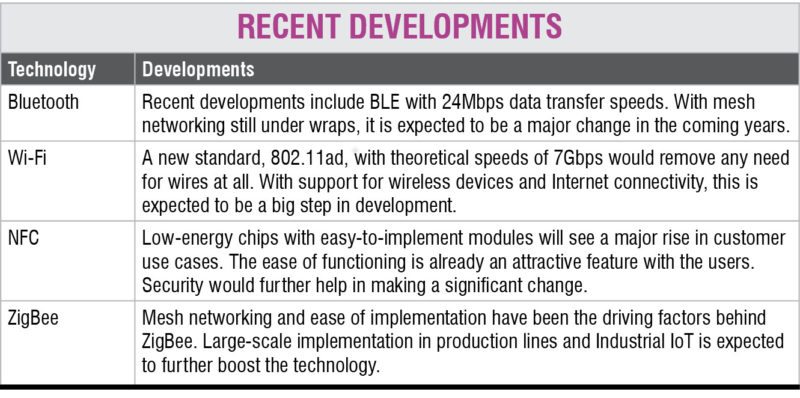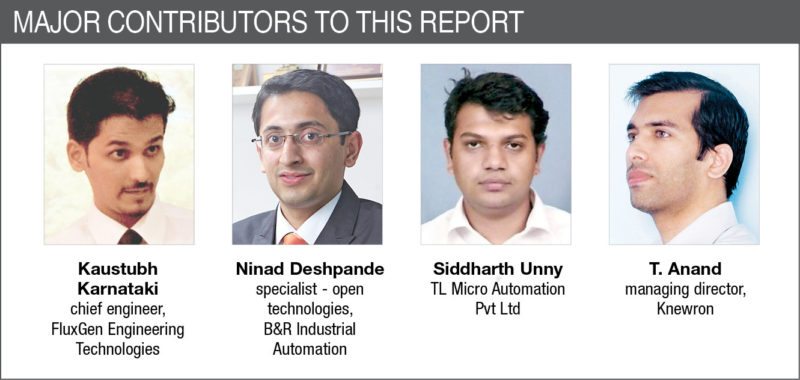Evolution of mobile communication has increased the need for faster, quicker and efficient means of sharing data, mobile payments, product tracking, human identification, health and others. Every day we use data-sharing applications like WhatsApp and Zapya, which employ technologies such as Bluetooth and Wi-Fi for their operation. Comparing this to the time of using wired connections with data speeds of 10Mbps to 12Mbps gives an estimate of how fast the technology is processing.
 While long-range data transmission has been more or less hogged by mobile networks, there are several contenders in short-range data transmission, too. Of these, the most popular ones like radio-frequency identification (RFID), Bluetooth, near field communication (NFC) and Wi-Fi are being made even more effective through various technological developments.
While long-range data transmission has been more or less hogged by mobile networks, there are several contenders in short-range data transmission, too. Of these, the most popular ones like radio-frequency identification (RFID), Bluetooth, near field communication (NFC) and Wi-Fi are being made even more effective through various technological developments.
Wearables have also created a rise in demand for these technologies. With the spreading demand of data transfer in wearables, these technologies will be front and centre. As Ninad Deshpande, specialist – open technologies, B&R Industrial Automation, says, “Wearables have redefined the market and have attracted a lot of attention, right from smartwatches to virtual reality gear.”
Developing features
Improvements in communication technologies is in terms of data transfer speed and range. With data rates of 24Mbps in Bluetooth (v.4.0) and up to 150Mbps (ideal conditions) in Wi-Fi (802.11n), these have firmly established themselves. RFID with some modulation has been converted to a hot product known as NFC. It is being experimented with bank transactions, vehicle parking, home and office security and other such areas of life. Due to low data rate and range, it finds suitability in applications where authentication is a necessity.
A look at individual technologies should provide a better understanding of the various developments taking place in the field.

Bluetooth. This go-to technology for media sharing can be found in every multimedia-enabled mobile handset (both smartphones and not-so-smartphones), computer systems, wireless devices such as speakers, printers and scanners, and many more. If you can work with programming, the uses are only limited by your imagination (and probably range). Due to the available transfer speeds, the typical uses are files, instructions and small media sharing.
NFC. In the evolution from RFID to NFC, many changes occured. Due to its very low data transfer range, accidental data transfer can be avoided. The biggest selling point for NFC is ease of use, and so it has found uses in security applications and bank transfers. T. Anand, managing director, Knewron, agrees, “Even if you are near the payment kiosk and the NFC tag is in your pocket, then payment is not happening by mistake. When you employ NFC, you basically touch the interface to the tag, making the distance almost zero.”
ZigBee. “ZigBee has wide uses in the home automation space, since it is a mature technology supporting mesh and large networks,” says Siddharth Unny, TL Micro Automation Pvt Ltd. He adds, “There was some talk of ZigBee being included in smartphones, enabling these to directly communicate with ZigBee networks. However, with the introduction of mesh networking in Bluetooth, addition of ZigBee to smartphones seems unlikely”.
Wireless fidelity. With the incorporation of Wi-Fi into mobile handsets (smartphones), it has become a common household name, and is often wrongly understood for the Internet. “Wi-Fi chipsets have been steadily improving in all respects, supporting greater speed, easier connectivity and low power operation,” adds Unny.
With regular advancements, newer and updated versions of communication chips are being launched on a daily basis. Let us take a look at the recent developing trends.
Personal networking connections. Unny says, “An exciting new development is Bluetooth mesh networking, which will allow Internet of Things (IoT) devices to be connected using Bluetooth, over large networks.”
ZigBee modules also provide a system to connect a mesh network. These often provide dedicated software, which provides a user-friendly graphical interface in configuring the modules. “Serial data monitoring with data logging, wireless range test applications, framing data packets, discovering neighbouring ZigBee modules and forming mesh networks with drag-and-drop configuration are some additional features,” adds Kaustubh Karnataki, chief engineer, FluxGen Engineering Technologies.
The high-speed capability of Wi-Fi allows gaming among a group of friends or accessing a private server as some of the non-Internet uses of Wi-Fi. With ever-developing protocols it can also be used for the setup of a private Intranet system, accessible only to specified users.
Low power and cost, high applicability. We have Bluetooth Low Energy (BLE) connectivity modules, with battery consumption in milli-amperes that find heavy use in IoT applications. XR and ZR modules from Atmel integrate a low-power Bluetooth system on chip (SoC) with an Atmel SMART ARM Cortex-M0 microcontroller (MCU) and a Bluetooth transceiver.
“We are excited to bring additional BLE solutions to the rapidly-growing wearable and IoT markets. Catering to wireless application designers of all levels, these give designers the critical tools to quickly and easily integrate Bluetooth Smart systems and connectivity,” says Bert Fransis, senior product marketing manager – Bluetooth Solutions, Atmel Corp.
CC3200 SimpleLink Wi-Fi and IoT solution, a single-chip wireless MCU, is another Wi-Fi module from Texas Instruments. This well-established module consists of an integrated MCU, reducing the need of peripherals. ARM core based Nordic nRF51822 and 8051 based TC CC2540 are other options.
Such products allow designers with no/less prior Bluetooth or RF design experience to add BLE connectivity to their designs. The new modules add to the existing BLE solutions, giving designers additional options to select from, cost-effective, ultra-small modules that require an external antenna or from fully FCC/CE/IC-certified modules with integrated antennae.
Comparing these BLE chips to the time when we carefully switched off Bluetooth after every use seems overkill.

Multiple applications in a small form factor. A major trend has been the integration of multiple technologies into a single chip. Anand agrees, “Today we are merging at least two technologies together like BLE+RF or BLE+Wi-Fi.” Multiple chipsets on a single chip reduce integration of several different components and also bill of materials.
LILY-W1 is a single-band 802.11n 2.4GHz Wi-Fi transceiver module from U-Blox. It provides Wi-Fi connectivity to a very broad range of products, along with LTE connectivity. Sized at 10mm×14mm, this module supports connectivity through secure digital input output (SDIO) or universal serial bus (USB), and can operate concurrently in client and micro-access point modes.
Bluetooth Smart with handy NFC. NINA-B1 BLE (Bluetooth Smart), a standalone module with integrated NFC capability, was recently announced by U-Blox. Comprising an antenna, radio transceiver, an embedded ARM Cortex M4F MCU and a BLE stack, the chip is design-ready for applications. The application memory of 512kB flash and 64kB RAM allows for future firmware upgrades to be performed over the air.
Other strong competitors like Texas Instruments CC2540, 2541 and 2564 have been popular in the market for quite some time now. Featuring an 8051 processor, 256kB flash and 8kB RAM, these handy chipsets support a 12-bit ADC, comparator, temperature sensor and battery monitor, hence reducing the cost on several peripherals.
Data transfer speed. Manufacturers have been trying to increase data transfer speeds for a while now. Entities like Intel, Qualcomm and Hitachi are working on yet another faster Wi-Fi standard, 802.11ad. With an ideal speed of about 7Gbps, transmission speeds are expected to reach a new high.
In recent news, Intel and Qualcomm claim to have gotten their respective 802.11ad (WiGig) chips and antennae to successfully link up. This offers speeds of up to 4.6Gbps under ideal conditions. Intel WiGig is very handy in removing the hassle of wires all over the desk. A docking station supports an Ethernet port and connectivity for an external Internet connection.
Hi-speed NFC. NTAG I2C plus NFC tags from NXP Semiconductors combine a passive NFC interface with a contact I2C interface. Features in the chip include hi-speed transfer, password protection, full memory-access configuration from both interfaces, an originality signature for protection against cloning and four times higher pass-through performance, along with energy-harvesting capabilities.
PN7462 family of single-chip NFC reader solutions from NXP combine a microprocessor with USB, for contact and contactless interfaces. According to a press release by NXP, “It is specifically designed for use in readers in applications including corporate access, hospitality or home banking.”
Employing the technology
Selection of a particular technology requires consideration of several parameters. According to Karnataki, “Power consumption, communication range, addressing methods and user-friendly configuration software are some important features to keep in mind while selecting a communication chip for designing a system.”
From a designer’s point of view, “TTL compatible I/O interface avoids the involvement of intermediate data converters,” he adds.
An important factor in employing any technology is the operating environment. The chipset selected must be capable of delivering data despite noise and other constraints. Employing the technology also depends on use cases: How the use case will be catered to, with a minimal number of components.
Anand adds, “For wearables, you are not going to design it on a hard PCB; you need a flexible one.” Unny supports the statement with, “Wearables have ensured large-scale adoption of wireless technologies. This has significantly brought down the cost of these chipsets and made these technologies available to the masses.”
Looking ahead
Unny states, “Wireless technologies were limited to industrial environments in the past. Wearables and smartphones have made these technologies available to the general public. Secure payments, object tracking, health and fitness tracking, and human security are some of the most significant use cases.”
Newer standards are being developed for Wi-Fi, which offer higher speeds than ever before. Bluetooth research has been focused on reducing energy requirements. Monetary transactions have been aided in part by NFC. After all, self-checkout lanes at Wal-Mart are the best ones, and if you could pay with just a tap of your mobile instead of swiping a card and entering a pin, the lanes would certainly move faster.
Saurabh Durgapal is working as technology journalist at EFY







